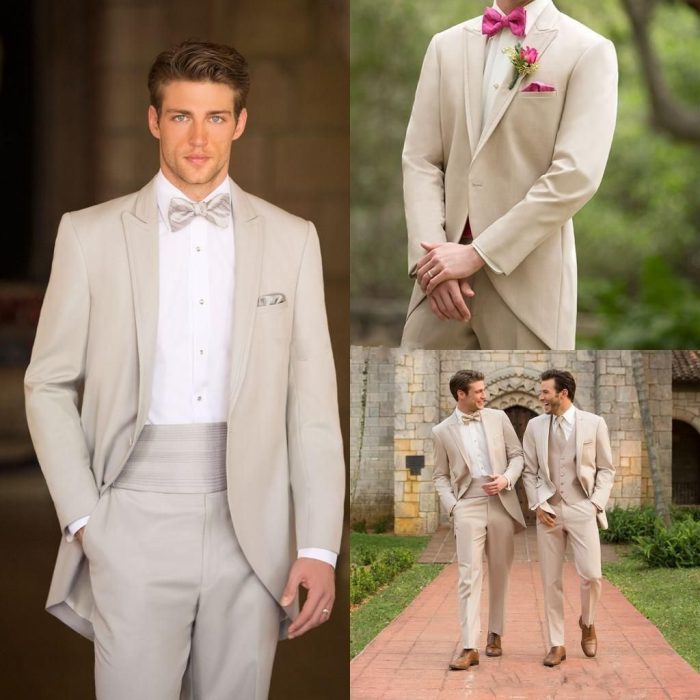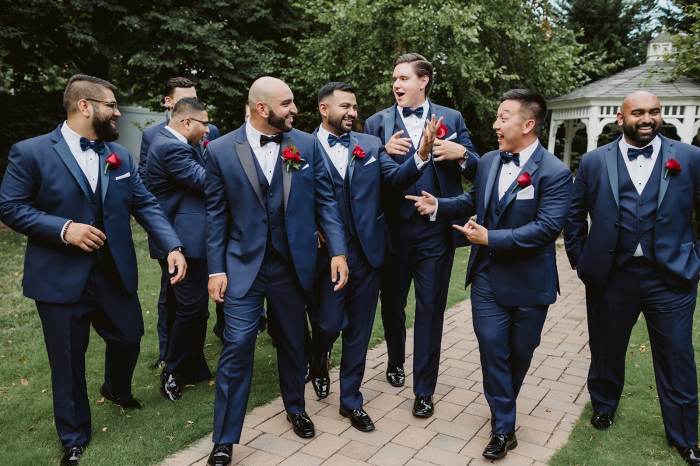A Journey Through Bridal and Groom Attire
Wedding dresses for bride and groom – Choosing the perfect attire for your wedding day is a significant step in planning your special event. From the bride’s gown to the groom’s suit, the selection process involves careful consideration of style, fit, and overall aesthetic. This exploration delves into the diverse world of wedding attire, guiding you through the myriad options available to create a look that reflects your unique personalities and wedding theme.
Bridal Gown Styles: A Timeless Evolution
The evolution of the traditional wedding dress is a fascinating journey reflecting societal shifts and changing fashion trends. Early wedding gowns often mirrored the prevailing fashion of the time, evolving from elaborate, richly embellished garments to the simpler, more streamlined silhouettes of the 20th century. Today, brides have an incredible array of styles to choose from, each offering a unique aesthetic.
Comparing Bridal Gown Silhouettes
Four prominent silhouettes dominate the bridal landscape: A-line, ballgown, mermaid, and sheath. The A-line, flattering on most body types, features a fitted bodice that gradually flares out to the hem. The ballgown, characterized by its full skirt and fitted bodice, creates a dramatic and princess-like look. The mermaid silhouette hugs the body closely until it flares out at the knees, accentuating curves.
Finally, the sheath gown, with its straight, fitted silhouette, offers a sleek and sophisticated aesthetic.
The Impact of Necklines on Bridal Gowns, Wedding dresses for bride and groom
The neckline plays a crucial role in shaping the overall look of a bridal gown. A sweetheart neckline, with its heart-shaped curve, adds a touch of romance. The V-neck, elongating the torso, offers a modern and elegant feel. A halter neckline, with its straps around the neck, provides a chic and contemporary look. The choice of neckline depends largely on personal preference and the desired level of formality.
Common Wedding Dress Fabrics
| Fabric | Properties | Suitable for | Considerations |
|---|---|---|---|
| Silk | Luxurious, smooth, drapes well | Formal weddings | Can be expensive, requires delicate care |
| Satin | Shiny, smooth, elegant | Various wedding styles | Can show imperfections, may wrinkle easily |
| Lace | Delicate, intricate, romantic | Formal and informal weddings | Can be delicate, requires careful handling |
| Tulle | Lightweight, sheer, creates volume | Ballgowns, layered skirts | Can be easily damaged, requires careful handling |
Groom’s Attire: Classic and Modern Options: Wedding Dresses For Bride And Groom
The groom’s attire is equally important in completing the wedding’s overall aesthetic. The choice of suit, color, and accessories should complement the bride’s gown and the wedding’s theme. Modern and classic options offer diverse choices to suit different tastes and styles.
Modern and Classic Groom’s Suits
Classic groom’s suits often feature a navy or charcoal gray suit in a traditional cut. Modern options embrace bolder colors, slimmer fits, and textured fabrics like velvet or linen. The choice depends on the groom’s personal style and the overall wedding theme.
Suit Colors and Patterns for Various Wedding Themes
A rustic wedding might call for a linen suit in a muted earth tone, while a modern wedding could feature a sleek navy suit with a subtle pattern. A classic wedding might opt for a timeless charcoal gray suit. The color and pattern should harmonize with the overall wedding palette and setting.
The Importance of Groom’s Accessories
Accessories elevate the groom’s look, adding personality and sophistication. A well-chosen tie, cufflinks, and pocket square can significantly impact the overall aesthetic. These details should complement the suit and reflect the wedding’s theme.
Appropriate Shoe Styles for Grooms
- Oxfords: Classic and formal, ideal for traditional weddings.
- Loafers: More relaxed and versatile, suitable for less formal settings.
- Monk straps: Stylish and sophisticated, offering a unique touch.
- Chelsea boots: Chic and modern, perfect for a contemporary wedding.
Matching Bridal and Groom Attire: A Harmonious Blend
Coordinating the bride and groom’s attire is key to creating a cohesive and visually appealing wedding aesthetic. The color palettes, textures, and fabrics should complement each other, reflecting the chosen wedding theme.
Complementary Color Palettes
Classic combinations like ivory and navy, blush pink and gray, or champagne and burgundy create elegant and timeless looks. More adventurous couples might opt for bolder combinations like emerald green and blush or deep teal and gold.
Wedding Outfits Based on Different Themes
For a rustic wedding: a lace A-line gown in ivory with a cream linen suit for the groom. For a modern wedding: a sleek sheath gown in ivory with a navy slim-fit suit for the groom. For a classic wedding: a ballgown in ivory with intricate beading and a charcoal gray suit for the groom.
Coordinating Textures and Fabrics
The texture of the bride’s lace gown can be complemented by the texture of the groom’s linen suit. The sheen of a satin gown can be balanced by the matte finish of a wool suit. Careful consideration of texture creates a visually pleasing harmony.
Wedding Theme Influence on Attire Selection
The wedding theme dictates the overall style and tone of the attire. A beach wedding might call for lighter fabrics and relaxed silhouettes, while a formal ballroom wedding would require more elaborate and sophisticated attire. The theme provides the framework for the couple’s style choices.
Visual Representations of Wedding Attire

Source: tendance-fashion.com
Visualizing the wedding attire helps solidify the couple’s vision and ensures a cohesive look. Detailed descriptions can bring the desired aesthetic to life.
Intricate Lace Wedding Dress
Imagine a wedding dress crafted from delicate Chantilly lace, featuring intricate floral patterns and a flowing cathedral train. The A-line silhouette accentuates the bride’s figure, while the lace adds a touch of timeless romance. The overall aesthetic is one of refined elegance and classic beauty.
Groom’s Three-Piece Suit
Picture a three-piece suit in a subtle herringbone pattern, crafted from fine Italian wool in a deep navy blue. The suit features a slim fit, accentuating the groom’s physique. The accessories include a silk tie in a complementary shade, polished black leather oxfords, and silver cufflinks.
Couple in Wedding Attire
Envision the couple standing amidst a lush garden, bathed in the soft golden light of sunset. The bride, in her flowing gown, radiates happiness, while the groom, in his impeccably tailored suit, looks on with adoration. Their poses are natural and affectionate, capturing the joy of the moment.
Impact of Lighting and Photography Styles
Soft, diffused lighting enhances the details of the attire, creating a romantic and ethereal atmosphere. A more dramatic lighting style can add depth and intensity to the photographs. The choice of photography style – candid, posed, or a combination – significantly impacts the final look.
Budget and Ethical Considerations in Wedding Attire

Source: springfieldcc.net
Balancing style with budget and ethical considerations is crucial for responsible and sustainable wedding planning. Affordable options and ethically sourced fabrics are increasingly important to many couples.
Affordable Yet Elegant Wedding Dress Options
Consider renting a wedding dress, purchasing a sample gown, or opting for a less expensive fabric like crepe or chiffon. Many designers offer beautiful gowns at various price points, allowing for flexibility within a budget.
Sustainable and Ethically Sourced Fabrics
Choosing organic cotton, recycled fabrics, or sustainably sourced silk reduces the environmental impact of the wedding attire. Supporting brands committed to ethical labor practices ensures fair treatment of workers throughout the production process.
Factors Contributing to Wedding Attire Costs
The cost of wedding attire is influenced by factors such as fabric type, embellishments, designer label, alterations, and accessories. Setting a budget early on helps prioritize choices and manage expenses effectively.
Budget-Friendly Yet Stylish Options
Shop at sample sales, consider off-the-rack options, and prioritize key elements like the dress or suit while opting for more affordable accessories. Careful planning and creative sourcing can help achieve a stylish look without exceeding the budget.
Query Resolution
What are some eco-friendly wedding dress options?
Consider dresses made from organic cotton, recycled materials, or sustainably sourced silk. Look for brands committed to ethical production practices.
So, we’re talking wedding attire, right? Finding the perfect wedding dress for the bride is a big deal, but don’t forget about the groom! While the bride often gets the spotlight, a well-chosen suit or even a unique tuxedo complements the overall look. To get some inspiration for both sides of the equation, check out this amazing resource on wedding dresses and gowns – it’s got tons of ideas.
Ultimately, coordinating the bride and groom’s outfits creates a cohesive and memorable wedding aesthetic.
How far in advance should I start shopping for my wedding attire?
Ideally, begin shopping 9-12 months before your wedding to allow ample time for alterations and potential delays.
What are some ways to save money on wedding attire?
Consider renting a dress or suit, shopping sample sales, or purchasing pre-owned attire in excellent condition. Prioritize quality over quantity in accessories.
Can the groom wear a different color suit than traditional black or navy?
Absolutely! The groom’s suit color can complement the wedding theme and the bride’s dress. Consider shades of gray, burgundy, or even lighter colors depending on the season and style.
